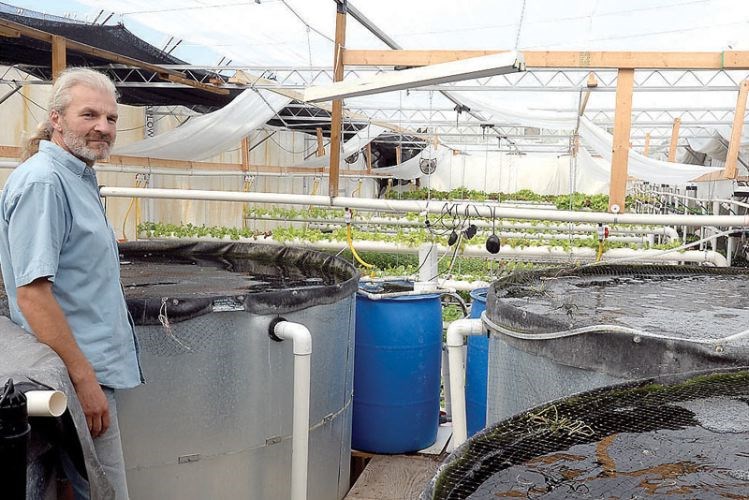While the B.C. Northern Exhibition celebrated the history of agriculture in the region, one Prince George couple is working on the cutting edge of food production.
Matthias and Jutta Zapletal of Northern Bioponics Ltd. operate a greenhouse on their rural property on Chief Lake Road. They grow and sell produce including basil, mustard greens, lettuce varieties, mint, strawberries and tropical tilapia freshwater fish.
The innovative system uses the principle of aquaponics: a combination of aquaculture, raising fish for food in enclosed tanks, and hydroponics - growing plants without soil by using nutrient-rich water.
"I built everything myself. You can pay people to do it... but it is very expensive," Matthias said. "After working 25 years as an engineer... I said it's time now to do something I really like. I grew up on a small farm. I always had a garden. You don't make a lot of money [as a farmer], but you always have enough to eat."
Matthias and Jutta, who is trained as an optics technician, immigrated from Germany to Canada in 1999. After several years of trying to have his German training recognized in Canada, he found himself living in Alberta and commuting to Florida to work.
"I worked for many years down in Florida. It became too much," he said.
The couple moved to Prince George and launched Northern Bioponics in August 2010, and sold their first harvest of basil in July 2011.
"It takes around three months before you get [nutrient] balance," Matthias said. "The first plants we grew, without enough nutrients, came up white."
Now their products are available at the Prince George Farmers' Market, Home Sweet Home grocery and Ave Maria Gifts and Health Foods. In addition, the sell their produce to a number of local restaurants.
"I believe aquaponics won't solve the world hunger problem, but it is another opportunity to grow year round," Matthias said.
HOW IT WORKS
The tilapia are raised in a series of tanks -segrated by age and development. Currently the Zapletals have about 2,000 fish, although they typically only sell 250-300 per year.
"I feed the fish, the water is drained and the [waste] solids go into a bioreactor," Matthias said.
The bioreactor uses bacteria and oxygen to break down the waste into nitrates -an important nutrient used by plants, he said.
"The plants work like a big filter. They take out everything, and the water goes back to the fish," he said. "It's completely closed."
The tropical tilapia, which thrive in water ranging from 22 to 24 C, allows Northern Bioponics to grow a wide range of produce, Matthias said. Some aquaponics systems have been created using trout, but the cold water required for the fish limits what types of plants can be grown.
Female tilapia also collect and incubate their fertilized eggs in their mouth until they hatch, Matthias said, which makes for simple and hands-off breeding.
The plant seeds are placed in reusable pots filled with baked clay pellets, and the pots are placed in floating trays or pipes that allows the water to be cycled through and absorbed by the plants.
The pellets and pots are all sterilized and reused. Everything that can be reused or recycled is, he said. They feed waste stems and leaves to their chickens.
Other than the food for the fish and about 1,000 litres of water a month to replace evaporation, the system requires few inputs, he said. It takes about 1.5 pounds of fish feed to create one pound of tilapia -highly-efficient compared to other protein sources like cows, pigs and chickens, he said.
"I can not spray anything, not even organic certified [pesticides], because they are toxic to invertebrates like the fish," Matthias said. "I have never had any disease in here [among the fish.]"
Pest control is done manually and with natural predators like ladybugs, which eat aphids.
Despite the high-tech nature of the system, it requires very little power to run, Matthias said.
"May to October, the greenhouse and 36,000 litres of water are heated only by solar. One big truckload of wood chips heats [the greenhouse] for the whole winter," Matthias said. "With a two-three kilowatt solar panel for power, I'd be completely off the grid."
A row of mirrors reflects sunlight into the greenhouse to extend the amount of available daylight during the short winter days. Matthias said they hope to add some artificial grow lamps this year to improve their winter growing time.
Even still, he said, the growing time for vegetables in the greenhouse is approximately half that needed to grow plants in Prince George's cool, short growing season. The greenhouse system allows Northern Bioponics to stage their plants so they can harvest on a continual basis.
LOCAL FOOD
Matthias said Prince George is behind other parts of the province in the local food trend.
Importing food from across North American and around the world is carbon-intensive, and means food must be treated to prevent spoilage.
National Geographic recently calculated the distance travelled by a typical fruit and vegetable basket in New York City. The total distance travelled by the 60 items in the basket was approximately 360,300 kilometres, with the average item travelling more than 6,000 km to arrive in New York.
Jutta said she hopes Prince George residents will think more about where their food is coming from and who is growing it.
"The farmers' market itself has existed for 20 years next year," she said. "We still have people come up and say, 'I have never been here, and I've lived here my whole life.'"



